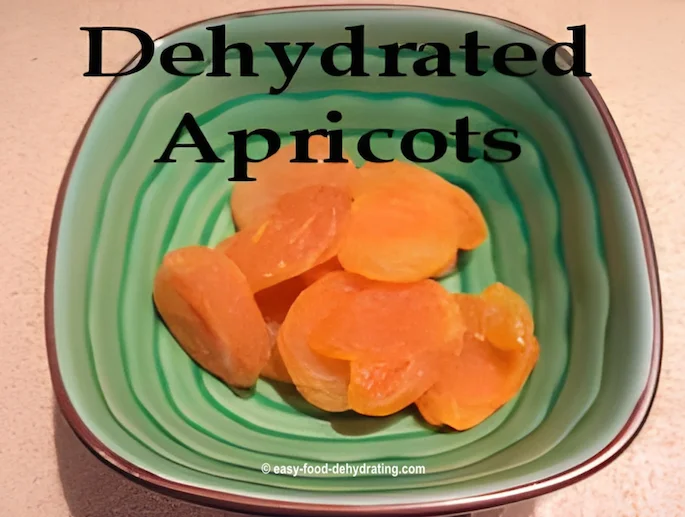What We Mean by “Dehydrate”
Here at Easy Food Dehydrating, “dehydrate” always means using an electric food dehydrator — the easy, reliable way to dry food at home.
- Home
- Dehydrating Fruits: Step-by-Step Guides by Type
- How to Dehydrate Apricots for Long-Lasting Flavor
How to Dehydrate Apricots
for Long-Lasting Flavor

Dehydrating apricots is one of the easiest ways to lock in their sweet, sun-kissed flavor for year-round snacking. With just a little prep, you can transform fresh or frozen apricots into chewy, nutrient-packed bites that store beautifully - no freezer required.
✅ Quick Answer: How do you dehydrate apricots?
Wash, halve, and pit apricots. Syrup-blanch for 3–4 minutes, then drain and place on dehydrator trays without overlapping. Dry at 125–135°F for 8–16 hours until pliable but not sticky. Store in airtight containers for long-lasting flavor.
Whether you want them for trail mixes, baking, or quick healthy snacks, learning how to dehydrate apricots at home gives you fresh fruit flavor that lasts for months.

You can also dehydrate canned apricots, but rinse off the syrup first to prevent sticky caramelization as they dry out on the dehydrator.
Apricot Nutrition Benefits You Don’t Want to Miss

VITAMINS: Vitamin A, followed by Vitamin C, and Vitamin E, with trace amounts of Folate, Choline, Vitamin K, Niacin, and Vitamin B6.
MINERALS: Potassium, Phosphorus, Calcium, and Magnesium, with trace amounts of Iron, Zinc, Selenium, Copper, and Manganese.
Apricots also have Omega-6 fatty acids.
How to Dehydrate Apricots: Step-by-Step With Syrup Blanching Secrets
It's time to get busy drying apricots in a dehydrator. Here's how:
If using frozen apricots (allow them to thaw first), and ignore steps 1, 2, and 3.
- Wash fresh apricots first, cut them in half, and remove the pits.
- Syrup-blanch the apricots by preparing a mixture of 1 cup of sugar, 1 cup of light corn syrup, and 2 cups of water. Bring to a boil, then add no more than 2 pounds of prepared fruit to the pan and simmer 3–4 minutes, then remove from heat and let them rest in the hot syrup for up to 30 minutes. This step is optional - it adds more sweetness but can soften fruit further, so skip if you prefer firmer halves.
- Arrange the apricots on your dehydrator trays, making sure they don't overlap. If you are using an Excalibur dehydrator, you may wish to leave out alternating trays if you find that your apricot halves are a tad tall and feel a bit cramped between the trays. I find the Nesco dehydrator better suited for dehydrating apricots due to having slightly taller spacing between their trays.
- Turn on your food dehydrator and set the temperature between 125°F and 135°F (or per your food dehydrator's instructions).
💡 Tip: Outside the U.S.? Most dehydrating temps here are listed in Fahrenheit - use our quick converter to see the Celsius equivalent for your machine.

- Apricots are pliable when dried.
- Drying time: between 8-16 hours.
NOTE: A lovely lady wrote to me on Facebook to say that her apricots, while blanching, turned into jam! So even though "all was not lost," making jam was not her intention!
I responded saying, "take out your fruit if/when you see it turning mushy." The aim of blanching is to crack the skins which makes the apricots dry faster on the dehydrator. Thanks!
| Fruit | Syrup Blanch Time | Notes |
|---|---|---|
| Peaches | 3–5 minutes | Skins loosen; flesh stays intact |
| Plums | 1–2 minutes | Skins crack quickly |
| Apricots | 3–4 minutes | Enough to soften skins, avoid mush |
Recommended blanch times for peaches, plums, and apricots.
Tip: For apricots, keep it to 3–4 minutes—remove as soon as skins loosen to avoid mush.
How to Tell When Dehydrated Apricots Are Done (No Guesswork Needed)
To check if your apricots are ready, take one off the dehydrator and slice it open. It should be flexible — not brittle — with no juice oozing out when you squeeze it.
💡 Pro Tip: Rotate your trays during drying for even results!
A Childhood Memory: Croissants and Apricot Jam Bliss

As a kid, my family and I spent our summers in a small seaside town in the South of France in the tiny naval village called Saint Mandrier. My favorite time of day was always breakfast!
It was designated "my job" to go shop at the patisserie each morning and return with a giant bag filled with warm, buttery croissants avec-beurre - croissants with butter.
The best part? Slathering those flaky croissants with thick apricot jam the moment I returned with the goodies. It was pure heaven on a plate.
And to work off all those sweet treats? A few quick dips in the sparkling blue waters of the Mediterranean kept our waistlines - and our smiles - in check.
Once you've mastered dehydrating apricots, you're just a step away from something even sweeter: homemade apricot jam! 🍯 Let’s dive in...
🍯 Easy Homemade Apricot Jam (From Fresh or Dried Fruit)

Ready to turn your dried or fresh apricots into something truly irresistible? 🍯 This homemade apricot jam is sweet, simple, and perfect for spreading on everything from toast to croissants.
And the best part? It’s an easy way to use up any extra apricots you have — no fancy equipment needed!
Ingredients:
- 4 cups of apricots, pitted and chopped
- 3 cups of sugar
- 1 cup of water
- 1 teaspoon of lemon juice
Directions:
- To make the jam, start by combining the apricots, sugar, water, and lemon juice in a large pot. Cook the mixture over medium heat, stirring frequently, until it comes to a boil.
- Once the mixture is boiling, turn the heat down to low and let it simmer for about 45 minutes, or until the apricots are very soft and the jam is thick.
- Once the jam has finished cooking, remove it from the heat and let it cool for a few minutes. Then, use a spoon to ladle it into jars or other containers. Be sure to seal the jars tightly and store them in the fridge.
And that’s all there is to it! Now you know how to make apricot jam at home. Give it a try the next time you have some extra apricots on hand - or get busy dehydrating apricots for long-term storage!
Apricot Dehydrating FAQs (Your Top Questions Answered)
How long does it take to dehydrate apricots?
How long does it take to dehydrate apricots?
Usually 8–16 hours at 125–135°F. They should be pliable, not brittle, with no moisture inside.
Do apricots need to be syrup-blanched before drying?
Do apricots need to be syrup-blanched before drying?
Yes, for best results. A quick 3–4 minute syrup blanch adds sweetness and helps skins crack, speeding up drying. Skip blanching if you prefer less sugar.
Can I dehydrate apricots in the oven?
Can I dehydrate apricots in the oven?
Yes, but ovens rarely go low enough. Use the lowest setting, prop the door open slightly, and rotate trays often. Expect longer drying times.
Do I need to peel apricots before dehydrating?
Do I need to peel apricots before dehydrating?
No peeling required. Just wash, halve, pit, and blanch. The skin helps hold shape during drying.
How long do dehydrated apricots last in storage?
How long do dehydrated apricots last in storage?
Stored in airtight containers in a cool, dark place, dehydrated apricots last 6–12 months. Vacuum sealing or freezing can extend shelf life.
Can I dehydrate canned apricots?
Can I dehydrate canned apricots?
Absolutely. Just rinse off the syrup first to prevent sticky caramelization.
How do I know when my apricots are fully dried?
How do I know when my apricots are fully dried?
Slice one open — it should be pliable but not juicy inside. No sticky fingers!
Thanks for joining me in learning how to dehydrate apricots! Once you’ve tried this method, you’ll always have a stash ready for snacking, baking, or even jam-making.
Want more ways to use your dehydrated food? Grab my free 5 Dried Food Recipes You'll Actually Love PDF — including carrot soup, minestrone, split pea soup, spicy beef jerky, and even banana cinnamon rolls. It’s my way of sharing a little extra flavor inspiration with you.
Grab 5 Dried Food Recipes You'll Actually Love
Here's where you can get your copy of our all new
5 Dried Food Recipes (That Actually Taste Great)
They're my all-time favorite easy dried food meals!
Get it here right now.
For Free!
Before You Go...
If you enjoyed this page, tap the ❤️ in the lower right-hand corner.
It saves this page to your Grow bookmarks so you can find it again later.
You’ll also see quick share buttons to copy the link, post to Facebook,
or save it straight to Pinterest.
















